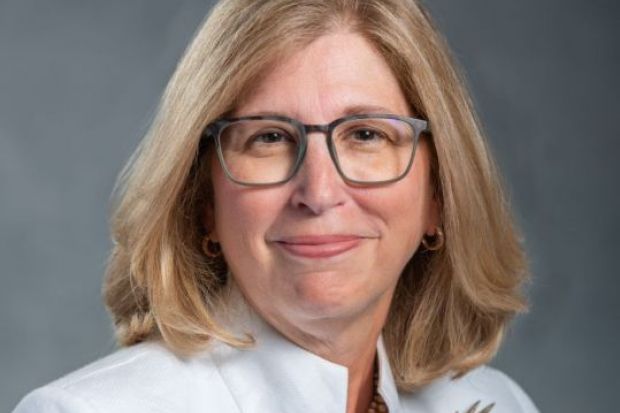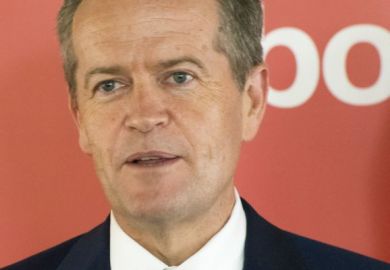Browse the full results of the World Reputation Rankings 2023
When Teresa Woodruff became provost of Michigan State University in 2020, she wrote a letter to all the students on campus. In it, she talked about extending empathy and grace to each other.
“Those weren’t terms that any provost [had] previously used within the academic setting,” she says.
Two years later, when she was asked to step up to the role of president, those words set the tone for her leadership as she took the reins of an institutions racked by crisis and loss.
In November 2022, she became interim president after what she describes as a “break of trust” between the board and Samuel Stanley, the previous president, over his handling of sexual misconduct cases. In addition to fragile trust in her office, she also inherited a legacy of unstable leadership – five presidents in five years. Then, on 13 February 2023, the Midwest campus was shaken by a shooting, in which three students were killed and five others wounded.
Values of empathy and grace that she had highlighted before her presidency took on new meaning as the leader tried to clear a path out of the chaos.
“Those [terms] actually became thematic. And those were important terms as we worked on our community healing efforts since February 13,” Woodruff says, adding that the shooting was the hardest of all the different crises that hit the university.
“What grace and empathy allows for is [university leadership] that is not a bureaucracy that is absent of soul,” she says, adding that it has been about creating a context for people to feel the confidence to work together.
The university leader says she has tried to do that by modelling these values to her community.
“It starts from the top. So, I think when people see me working comfortably and confidently and listening comfortably and confidently, and leaning on others, it creates a dynamic that is permissive for others to also do the same.”
However, she believes that it might have been harder to impress these values on the university community had they been introduced only at a time of crisis and difficulty.
“February 2023 wasn’t the first time we were using those concepts. If it was the first time, it might have been…dissonant for people to hear those terms, and to really trust and believe that we could work in that way,” she says.
Through this experience, Woodruff has been assured of a leadership framework that transcends circumstances: “I think that’s also part of leadership – the kinds of ways in which you lead in the good times also have to be resilient and ready for the bad times.”
Woodruff, who joined Michigan State in 2020 and whose husband is also a professor there, constantly proclaims her unwavering pride in the US university. It could come across as naive given the challenges that have rocked the institution over the past few years. But Woodruff defends her attitude, saying that this is just another area where “grace-giving” has been important for her and the university community.
“We needed to give each other grace in that moment to feel that it was OK to be proud of Michigan State, even in a time of extreme turmoil,” she says.
This is especially important, she continues, because different members of the community are on “different paths” or at “different paces” in recovering from their experiences at the institution. The community includes those who were at “the centre of the concentric circle” and deeply affected by the shooting, as well as others – about a quarter of the current student body of more than 51,000 students – who were not there when it happened.
“There was no one individual story that was everyone’s story. You had to appreciate that each person comes with their history and their understanding and their feelings about where we were and where we’re going,” the president explains.
Alongside this leadership ethos, policy changes have been rolled out at Michigan State. In light of the handling of the sexual misconduct cases, there are new disciplinary policies on egregious behaviour by faculty and a rewritten tenure policy. Meanwhile, the campus shooting has prompted an $8 million (£6.3 million) enhancement of safety and security measures.
Woodruff says she has also invested in students and reminded them of the quality and excellence to be found at the institution, in a bid to mitigate a “creeping cynicism” that had developed amid the management instability.
The ratio of student adviser to student has ramped up from 1 in 3,000 to 1 in 500. New honorifics programmes for faculty and students have been set up, too. And last autumn, the university welcomed its largest undergraduate class ever; there are now 40,483 undergraduates in total, almost 1,300 more than the year before.
But Woodruff's efforts to rebuild trust have extended beyond the university walls.
“I’ve been on tractors harvesting sugar beets, in the state of Michigan; I’ve been out milking cows,” Woodruff says, as she describes the work she felt she needed in her role leading a public state university.
She’s been busy not just sharing lunches and dinners with students and visiting the various university offices and departments, but also in meeting the people across Michigan’s 83 counties.
Woodruff says it was critical that she not be insular and withdrawn. By being instead present with Michiganders, she has tried to affirm the university’s commitment to the public, to hear their stories and to share with them the excitement and excellence to be found at the university.
Before Woodruff joined Michigan State, she was a renowned research scientist (and dean and associate provost for graduate education) at Northwestern University in Illinois. The biologist, who has 10 patents to her name, thinks that some of her work there prepared her for the challenges in her current role because it was in its own way also about leading through uncharted territory.
At the start of her career, she says: “There were no corridors of communication between oncologists and reproductive scientists. And there was no way to bridge the gap [between] basic science and the fundamental science coming into new healthcare,” recalls Woodruff.
As Woodruff went on to close that very gap through her work, she also coined the term “oncofertility”, in 2006, giving structure to an emerging field of medicine: fertility management for young cancer patients.
It was this effort that sharpened her ability to discern a vision in unprecedented circumstances and to unite people around a common purpose. It thus became a “playbook” for her tenure at Michigan State, she says.
It also laid the groundwork for a more collaborative way of working. “I’m a big tent person,” Woodruff says. Even though leaders need to make “principled decisions at the end”, gathering wisdom, insight and judgement from those around them can help them reach faster and better outcomes than when working alone, she believes.
She has recruited more than half the deans who now form the leadership at the university, and she believes that the institution is now in a position to move on and put the crises behind it.
“You’re never the leader forever at an institution like ours,” she says, explaining that building a longer-lasting foundation of strong leadership is crucial.
Last August, Woodruff announced that she would not pursue permanent presidency. Kevin Guskiewicz, until recently chancellor of the University of North Carolina at Chapel Hill, has since been elected to the position and will take over in March.
As she concludes her time in the role, Woodruff feels that she has been able to put the institution back on track. “We were on kind of a shoal, and we had headwinds. Sailing a ship during headwinds can be very difficult. So, my [goal] was to put the university into safe harbour.”
At the same time, the work of building the university’s reputation is an ongoing one, she says.
“I think reputation [management] has to be constant. You don’t earn it and then it’s maintained forever. You have to continue to hone excellence, for excellence is ephemeral,” she says.
For her, increasing prestige and excellence is also tied up with the personal experiences of students. “It’s in each individual’s hand that I shake at graduation, in each life that’s transformed.”
This is part of our “Talking leadership” series with the people running the world’s top universities about how they solve common strategic issues and implement change. Follow the series here.
Register to continue
Why register?
- Registration is free and only takes a moment
- Once registered, you can read 3 articles a month
- Sign up for our newsletter
Subscribe
Or subscribe for unlimited access to:
- Unlimited access to news, views, insights & reviews
- Digital editions
- Digital access to THE’s university and college rankings analysis
Already registered or a current subscriber? Login







